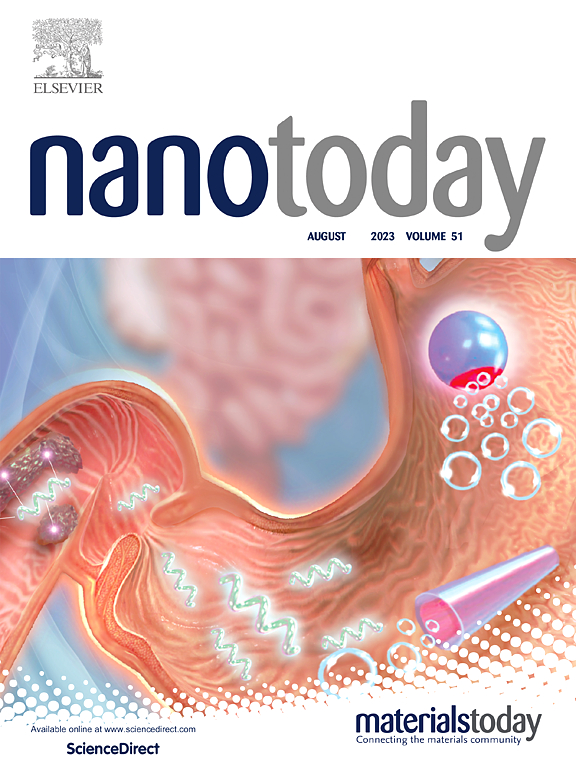结合自噬抑制和ROS清除的生物杂化纳米颗粒用于低温癌症光热治疗
IF 13.2
1区 材料科学
Q1 CHEMISTRY, MULTIDISCIPLINARY
引用次数: 0
摘要
光热疗法(PTT)需要在相对较低的温度下有效地消融癌细胞,并且对正常组织的热损伤最小,但在癌细胞中存在与自噬相关的保护性热阻和活性氧(ROS)诱导的正常细胞损伤。在此,我们筛选了姜黄素-铁超小纳米颗粒(curc - fe),具有高效的光热转化效率(η = 43.38 %)和清除ROS的能力。此外,我们还构建了CRISPR/Cas9质粒(pCas-ATG5/ATG7)来安全、精确地敲低保护性自噬以减轻热阻。由阴离子的cu - fe和pCas-ATGs组成的核心cu - fe /ATG@TKPF (CFA@T),通过静电相互作用被阳离子的硫代交联氟化聚乙烯亚胺(TKPF)包裹。此外,CFA@TC是由CFA@T通过希夫碱包被酸性ph响应壳OHC-PEG-CHO形成的。由于其对pH和ROS的双重反应性,CFA@TC在静脉注射后表现出有效的肿瘤靶向和摄取。在652 nm激光照射下,CFA@TC通过抑制自噬表现出增强的根除癌细胞的功效,同时在体内和体外通过清除细胞内ROS减轻炎症反应。综上所述,我们的研究提供了CRISPR可以有效抑制自噬的概念证明,其与ros诱导的炎症反应缓解的结合可以进一步改善PTT。本文章由计算机程序翻译,如有差异,请以英文原文为准。
Integrating autophagy inhibition and ROS clearance in biohybrid nanoparticles for low-temperature cancer photothermal therapy
Photothermal therapy (PTT) demands efficient cancer ablation at relative low temperatures and minimal thermal damage to normal tissues, but suffers from both the protective autophagy-related thermal resistance in cancer cell and reactive oxygen species (ROS)-induced damage to normal cells. Here, we screened out curcumin-Fe ultrasmall nanoparticles (Cur-Fe) that manifested efficient photothermal conversion efficiency (η = 43.38 %) and ROS scavenging ability. Additionally, CRISPR/Cas9 plasmids (pCas-ATG5/ATG7) were also constructed to safely and precisely knockdown the protective autophagy for thermal resistance alleviation. The core Cur-Fe/ATG@TKPF (CFA@T), which was composed of anionic Cur-Fe and pCas-ATGs, was encapsulated by cationic thioketal-crosslinked and fluorinated polyethyleneimine (TKPF) via electrostatic interaction. Further, CFA@TC was formed by CFA@T coated with an acidic pH-responsive shell OHC-PEG-CHO via Schiff base. Attributed to its dual responsiveness to pH and ROS, CFA@TC exhibited efficient tumor targeting and uptake following intravenous injection. Upon irradiation with a 652 nm laser, CFA@TC demonstrated enhanced efficacy in eradicating cancer cells by inhibiting autophagy, while concurrently mitigating inflammatory responses through intracellular ROS scavenging in vivo and in vitro. Taken together, our study provides a proof-of-concept that CRISPR can be effective for autophagy inhibition, and its integration with ROS-induced inflammatory responses relief can further improve PTT.
求助全文
通过发布文献求助,成功后即可免费获取论文全文。
去求助
来源期刊

Nano Today
工程技术-材料科学:综合
CiteScore
21.50
自引率
3.40%
发文量
305
审稿时长
40 days
期刊介绍:
Nano Today is a journal dedicated to publishing influential and innovative work in the field of nanoscience and technology. It covers a wide range of subject areas including biomaterials, materials chemistry, materials science, chemistry, bioengineering, biochemistry, genetics and molecular biology, engineering, and nanotechnology. The journal considers articles that inform readers about the latest research, breakthroughs, and topical issues in these fields. It provides comprehensive coverage through a mixture of peer-reviewed articles, research news, and information on key developments. Nano Today is abstracted and indexed in Science Citation Index, Ei Compendex, Embase, Scopus, and INSPEC.
 求助内容:
求助内容: 应助结果提醒方式:
应助结果提醒方式:


